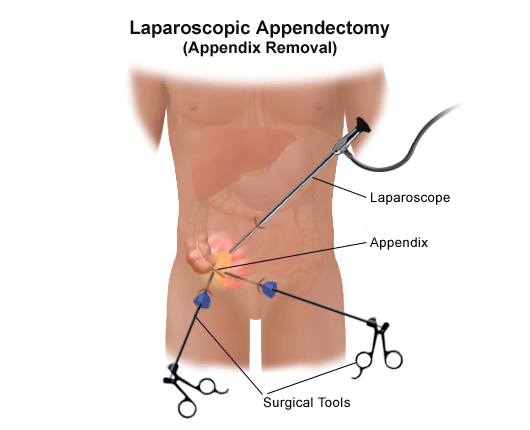Appendicitis | Diagnosis & Treatments
How is appendicitis diagnosed in children?
An appendicitis diagnosis for children will include a complete medical history and physical examination. It also may include:
- abdominal ultrasound
- computed tomography (CT scan)
Other appendicitis diagnostic tests for children may include:
- Blood tests: These tests are done to evaluate the infection, or to determine if there are any problems with other abdominal organs, such as the liver or pancreas.
- Urinalysis: This test detects any bladder or kidney infection, which may mimic the symptoms of appendicitis.
How is appendicitis treated in children?
Specific treatment for appendicitis will be determined by your child's health care provider based on the following:
- the extent of the problem
- your child's age, overall health, and medical history
- the opinion of the surgeon and other health care providers involved in the child's care
- your child's tolerance for specific medications, procedures, or therapies
- expectations for the course of the problem
- your opinion and preference
Because of the likelihood of an infected appendix rupturing and causing a severe, life-threatening infection, health care providers will often recommend that the appendix be removed with an operation.
What happens during appendix surgery for children?
The appendix may be removed in two ways:
- Open method. Under anesthesia, an incision is made in the lower right-hand side of the abdomen. The surgeon finds the appendix and removes it. If the appendix has ruptured, a small drainage tube may be placed to allow pus and other fluids that are in the abdomen to drain out. The tube will be removed in a few days, when the surgeon feels the abdominal infection has subsided.
- Laparoscopic method. This procedure uses several small incisions and a camera called a laparoscope to look inside the abdomen during the operation. Under anesthesia, the instruments the surgeon uses to remove the appendix are placed through the small incisions, and the laparoscope is placed through another incision. This method is not usually performed if the appendix has ruptured.
After surgery, children are not allowed to eat or drink anything for a specified period of time so the intestine can heal. Fluids are given into the bloodstream through small plastic tubes called IVs until your child is allowed to begin drinking liquids. Your child will also receive antibiotics and medications through the IV to help her feel comfortable. Eventually, children will be allowed to drink clear liquids (such as water, sports drinks, or apple juice), and then gradually advance to solid foods.
Is immediate surgery always necessary if a child has appendicitis?
Health care providers may recommend non-operative treatment of a ruptured appendix if there is a contained abscess and the child is stable. In some cases in which the appendix has ruptured and formed a localized abscess, a health care provider may recommend that the appendix not be removed right away. Instead, your child may receive treatment with intravenous antibiotics given through an intravenous catheter (called a peripherally inserted central catheter or PICC line) for about 10 to 14 days. This may be done along with CT- or ultrasound-guided drainage of the abscess. This allows the infection and inflammatory process to resolve. Your child will then undergo an elective (planned) interval appendectomy six to eight weeks later.
A child whose appendix ruptured will have to stay in the hospital longer than the child whose appendix was removed before it ruptured. Some children will need to take antibiotics by mouth for a period of time specified by the health care provider after they go home.
What happens after my child leaves the hospital?
Your physician will generally recommend that your child not do any heavy lifting, play contact sports, or "rough-house" for several weeks after the operation.
If a drain is still in place when your child goes home, she should not take a tub bath or go swimming until the drain is removed. Your child may need to take antibiotics at home to help fight the infection in the abdomen. You will be given a prescription for pain medication for your child to take at home to help her feel comfortable. Some pain medications can make your child constipated, so ask your physician or pharmacist about any side effects the medication might have.
Moving around after surgery rather than lying in bed can help prevent constipation. Drinking fruit juices and eating fruits, whole grain cereals, and breads and vegetables after being advanced to solid foods can help with constipation as well. Most children who have their appendix removed will have no long-term problems.



